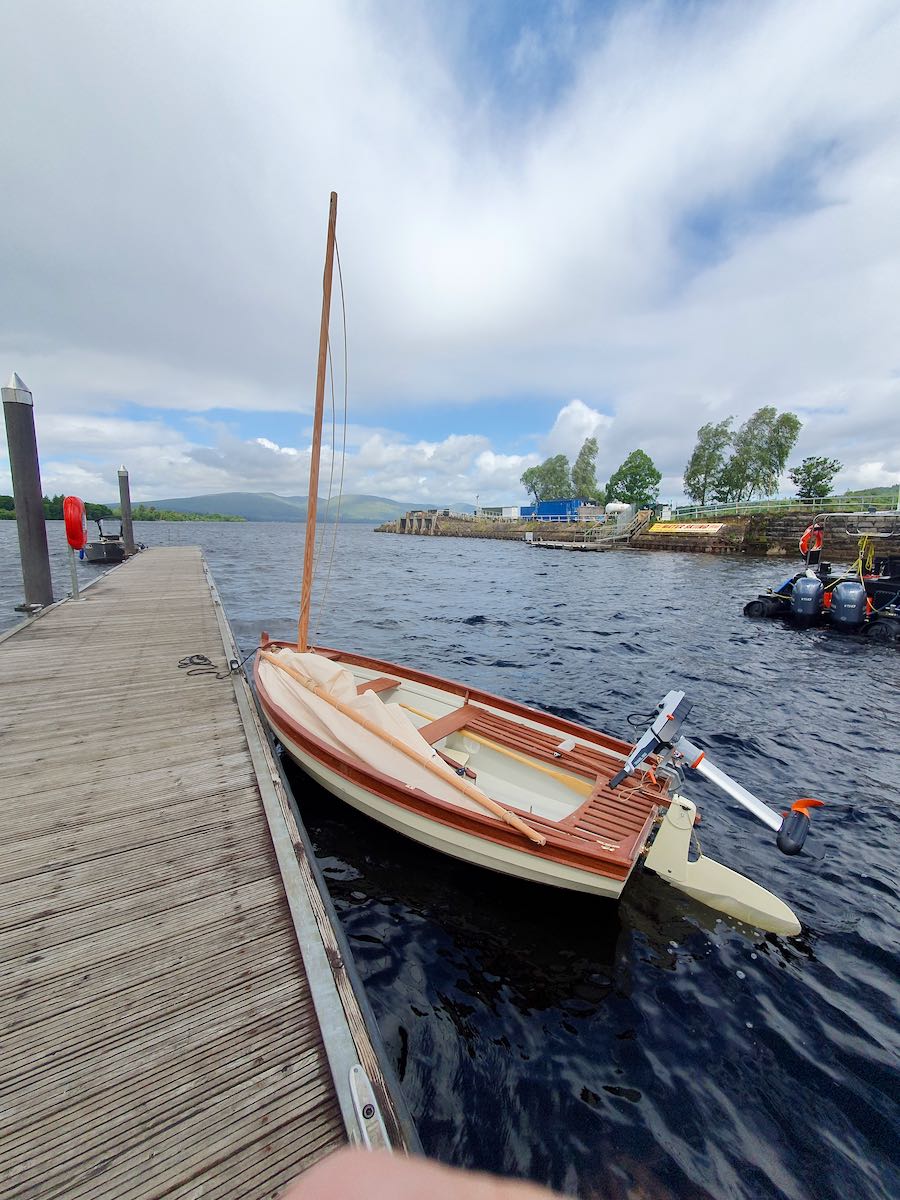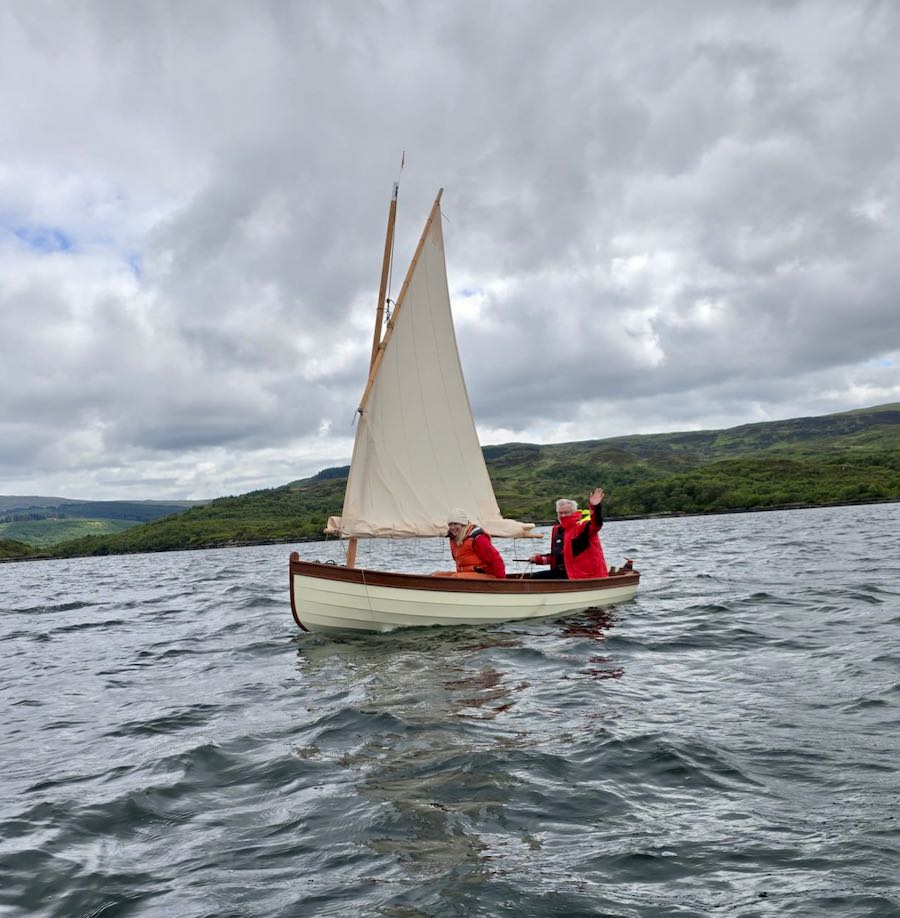A Morbic in Scotland
|
A trip to gather ideas
I had reached the stage in my build where I had turned the hull for the first time and now had to make choices as to how to fit the internals. I had scoured the forum and internet to see what others had done to help me, there was a lot of good ideas and I thought the best way to help me reach a decision was to try and see a good selection of boats and more importantly to meet other owners to hear their thoughts. To this end I contacted several owners by email through the forum and was able to set up a trip to meet them driving from Scotland to the Chichester area with a few stops on the way. Thanks to Paul W for helping me with this planning. First of all, I would like to thank all those I met for generously sharing their time and advice. I rapidly came to the conclusion that all Morbic owners are nice people. The icing on the cake for me was the opportunity to sail with Graham on Sistership in Chichester harbour. A great opportunity and one that thankfully confirmed that I had started to build the correct dinghy. During my trip I saw 8 dinghies (or 8 1/4 if you include Mike’s quarter scale model!), Aura, Bodicca, Half-moon, Proteus, Sistership and Swefn with a further 2 still being built. There was a mix of builds, one professional build, several using Alec Jordan’s kit, one using CNC’d parts and one hand made but in all cases the standard of build and finish was very high. All a real credit to their builder s and the many hours they must have spent building their boats. There was a fair range between those that had been built 100% to plan and those who had been modified to suit the owner’s interests and requirements. The only common issues that were raised were the construction of the rudder and the boom jaw. There have been reports of problems with the strength of the rudder cheek fixings and most people have added bolts or screws to reinforce the assembly. I don’t think I saw any examples where the boom jaw had been used and a rope loop or bleater was used in its place. There was a consensus that the buoyancy chambers should not be filled with foam, and some people used empty bottles or plastic balls in the chambers in case the chamber was ruptured. There wasn’t strong support for the fixed foot rests and these were absent or replaced by a removable foot rest. Only one person had made a set of oars to Vivier’s design and several people commented that their oars were a bit short but that storing and handling longer oars were difficult. Again most people had used oarlocks rather than thole pins. One development in some of the boats was the addition of an extra floor locker, originating on Port-na-Storm’s Sistership. These give extra stowage and an alternative lower seat to the forward thwart. Of the 8 dinghies I saw the majority (6) were built for lug sail with only two built to allow sailing as a sloop or lug. I saw a few variations in rigging with one boat using a rope traveller and the rest using a block on the centre board case for the main sheet. Some people had added lazyjacks and I saw how these made things easier when raising and lowering the main sail. Again with finishing there were differing views on the use of two part finishes, which were felt to provide a hard finish better able to stand up to day to day knocks but were more difficult to touch up in case of damage. Several people advocated the use of oil rather than varnish for the brightwork. Finally there was a multitude of small details that people had adopted including, adding floorboards (a lot of work to add and presented a snagging point for the main sheet), slats on the seating (look good but again a lot of work with cushions an alternative idea), small scuppers at the aft corners above the seating to drain water that collects there, additional tie off points for fenders etc. In conclusion, my thoughts are to finish my Morbic as a balanced lug for simplicity, I will install the forward thwart as the design but fix it with screws in case I decide to change the layout in the future. I am actively considering using an open mast partner (as in the sloop design) to make it easier to raise and lower the mast. There are also several detailed ideas I saw that I may incorporate depending on how time and motivation go. I had a very enjoyable time meeting and discussing things with all the people I met and thanks to them again. |
|
My Morbic now has a name, Alex, named after my new grandson born in April (I think male names are OK for boats now a days and it has several advantages - easy to communicate, easy to spell phonetically and relatively few letters to buy!)
I built it as a balanced lug and made some small tweaks to the design such as adding slatted seats and making a mast partner with an open gate like the sloop version for ease of raising the mast. It was launched on the 6th June at Balloch on Loch Lomond, no great fanfare or ceremony just myself and a friend. There was rather more wind than I would have liked for a maiden sail but it behaved very well under one reef and we had an hour or so on the water without incident. The only issue I found was that when using the outboard that the raised rudder interacted with the outboard and it was better to ship the rudder when using the outboard. Since then I found that it is best to keep the outboard fixed dead ahead and use the rudder to steer, I don’t have full movement of the rudder as it clashes with the propeller but enough of most situations.  Alex went under more testing sea trials last week on Loch Sunnart at a DCA rally. We had typical west coast weather, mostly dry with some showers and variable winds that often tended to strengthen in the afternoon resulting in a very lumpy sea that we had to try and beat through until we resorted to the outboard. The Morbic coped very well with the range of conditions, showing a good turn of speed and feeling secure in the gusts of wind. I reefed the sail at times and found this easy to do; although I sometimes found it difficult to tack with a reef in, probably due to my lack of experience. I also suspect the weight of the outboard tended to lift the bow and I wonder if this was catching the wind something I will need to experiment with to try and overcome this issue. Overall I am delighted with the Morbic and it was admired by all on the meet. I look forward to sailing it this season and then tidying up some details through the winter.  I will update my blog which fell by the wayside in my focus to complete the build. I will also post descriptions of some details that may be of interest in this forum. I am thankful I made the trip to see a selection of other Morbics earlier this year. It was good to meet other owners and see their Morbics and discuss the finer points of the boats. They were all very helpful and I would like to thank them all for their time and advice. |
|
Administrator
|
Lovely to see your notes and pics David.
Other Morbic lovers may be interested in some points I sent directly to you:- Male name – No prob. We refer to Proteus as “she”. “ALEX” is clever – all straight lines = easily carved! Tacking when fully reefed is sometimes tricky, even with the benefit of jib. An option sometimes available is to gybe, though conditions sometimes discourage this. One wonders whether your slatted seats have moved the CG astern? - (See your lower pic.) Weight of outboard might exacerbate this. Down at stern is probably detrimental:- (1) More windage on the bow, i.e. presumably tends to turn her downwind, (as you noted). (2) Stern low puts transom underwater which creates eddies/drag. The curve of the hull rises toward the transom so the flow lines are much more streamlined if the stern is slightly above water. – To enable this when solo I tend to sit on the thwart except when on the run. You'll recall that when building, the top of the CB case was horizontal. (see Vivier's plans) (Learners, or pedants, might mount a spirit level there.) Outboard/rudder clash – Same with us. Maybe a long-shaft motor mounted up on the higher part of the transom would work? Gate for easier stepping the mast - Clever! |
|
Hello David.
Have you found that the Torqeedo is powerful enough to push through a decent chop? Cheers Hugh |
|
Hello Hugh, Good to hear from you and yes I have been impressed with the Torqeedo's performance in choppy water. It is a balance between speed and distance but I was able to motor for 4 miles in moderate chop and 3 miles against the wind in a heavier chop. The version I have shows your speed over land and gives an estimate of the capacity left in the battery expressed as a distance which is very helpful. Graham, owner of Sistership also has a Torqeedo and somewhere (I can't remember where) he posted some details of the range he got from it. I clamp the Torqeedo to the starboard of the rudder which works well. The only issues I find with it are that the weight at the rear seems to make the boat harder to tack. Secondly the propeller can foul the rudder even with the rudder raised and if I try and motor the rudder and motor tend to fight each other and it is best to either keep the motor steady and steer with the rudder or to ship the rudder and use the motor on its own. otherwise I like the Torqeedo a lot, no fuel, no smell and starts instantly! |
|
Thanks for the helpful comments, David. That sounds like useful performance.
From what I can see on line, the Torqeedo seems easy to pull apart and stow - definitely easier to deal with than an equivalent petrol engine. |
«
Return to MyMorbic Sail-&-Oar Dinghy UK Network
|
1 view|%1 views
| Free forum by Nabble | Edit this page |

